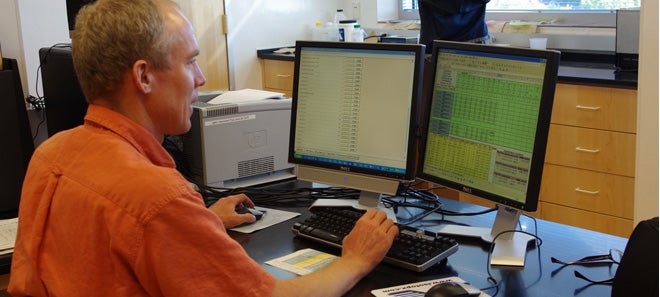
The Isotope Geology Laboratory uses a variety of data reduction environments for both ID-TIMS and LA-ICPMS analyses, many of them developed in-house and utilizing the familiar spreadsheet environment with or without associated Visual Basic automation codes.
ID-TIMS
UPbR
The UPbR spreadsheet-based ID-TIMS U-Pb data reduction uses the algorithms of Schmitz and Schoene (2007)*, and includes the ability to use all mixed 202Pb-205Pb-233U-235U-236U spikes, as well as Th/U corrections, geochemical parameter calculations, and formatted data table generation. The algorithms for alternative spike calculations not published in Schmitz and Schoene (2007) are detailed in Alternative-Spike-Eqns.docx. A more sophisticated sample template file containing enhancements like weighted mean calculation, comprehensive Th/U disequilibrium correction alternatives, outlier rejection calculations, and analysis of variance graphs is available as BSULab_UPbR21_Anyone.xlsx.
Schmitz, M. D. and Schoene, B. (2007) Derivation of Isotope Ratios, Errors and Error Correlations for U-Pb Geochronology Using 205Pb-235U-(233U)-Spiked Isotope Dilution Thermal Ionization Mass Spectrometric Data, GEOCHEMISTRY GEOPHYSICS GEOSYSTEMS, VOL. 8, Q08006, doi:10.1029/2006GC001492.
*Note that in the pdf of Schmitz and Schoene, Table 1 was partially compromised by omission of the abbreviations for tracer isotope ratios. All tracer isotope ratios end in “t”, e.g. “R85t” is the tracer 238U/235U. All measured ratios (partly mislabeled in Table 1) end in “m”, e.g. “R85m” is the measured 238U/235U.
Tripoli
Tripoli is a Windows-based program developed by Jim Bowring and the CIRDLES lab, which imports mass spectrometer raw data files and supports the interactive review of isotopic data. Tripoli facilitates the visualization of temporal trends and scatter during measurement with statistically rigorous filtering of data and implements point-by-point application of mass fractionation correction, oxide correction and spike stripping.
In the IGL we routinely use Tripoli to filter raw mass spectrometer data prior to import into the UPbR ID-TIMS software.
Pb-MacDat
Pb MacDat 2007 is a legacy ID-TIMS data reduction environment developed throughout the 1990’s by Clark Isachsen and Drew Coleman, and based upon the algorithms of Ken Ludwig’s PB-DAT program and error equations published in 1980 in EPSL. This version corrects an error in the calculation of 206Pb*/238U ratio errors found in Ludwig’s original PB-DAT source code; view Clark Isachsen’s tutorial on the use of Pb-MacDat on the EARTHTIME Labshare page.